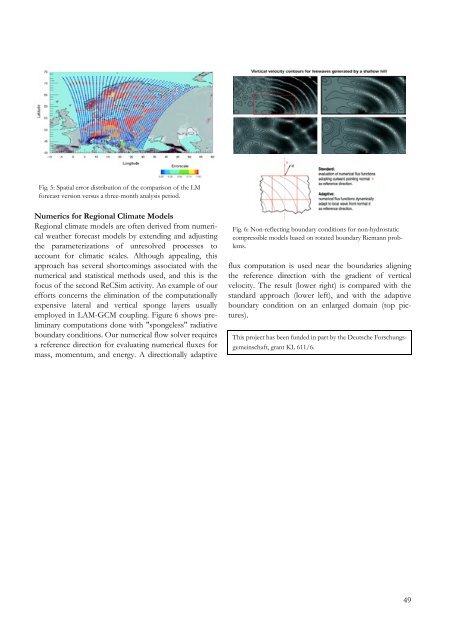PIK Biennial Report 2000-2001 - Potsdam Institute for Climate ...
PIK Biennial Report 2000-2001 - Potsdam Institute for Climate ...
PIK Biennial Report 2000-2001 - Potsdam Institute for Climate ...
Create successful ePaper yourself
Turn your PDF publications into a flip-book with our unique Google optimized e-Paper software.
Fig. 5: Spatial error distribution of the comparison of the LM<br />
<strong>for</strong>ecast version versus a three-month analysis period.<br />
Numerics <strong>for</strong> Regional <strong>Climate</strong> Models<br />
Regional climate models are often derived from numerical<br />
weather <strong>for</strong>ecast models by extending and adjusting<br />
the parameterizations of unresolved processes to<br />
account <strong>for</strong> climatic scales. Although appealing, this<br />
approach has several shortcomings associated with the<br />
numerical and statistical methods used, and this is the<br />
focus of the second ReCSim activity. An example of our<br />
ef<strong>for</strong>ts concerns the elimination of the computationally<br />
expensive lateral and vertical sponge layers usually<br />
employed in LAM-GCM coupling. Figure 6 shows preliminary<br />
computations done with "spongeless" radiative<br />
boundary conditions. Our numerical flow solver requires<br />
a reference direction <strong>for</strong> evaluating numerical fluxes <strong>for</strong><br />
mass, momentum, and energy. A directionally adaptive<br />
Fig. 6: Non-reflecting boundary conditions <strong>for</strong> non-hydrostatic<br />
compressible models based on rotated boundary Riemann problems.<br />
flux computation is used near the boundaries aligning<br />
the reference direction with the gradient of vertical<br />
velocity. The result (lower right) is compared with the<br />
standard approach (lower left), and with the adaptive<br />
boundary condition on an enlarged domain (top pictures).<br />
This project has been funded in part by the Deutsche Forschungsgemeinschaft,<br />
grant KL 611/6.<br />
49

















